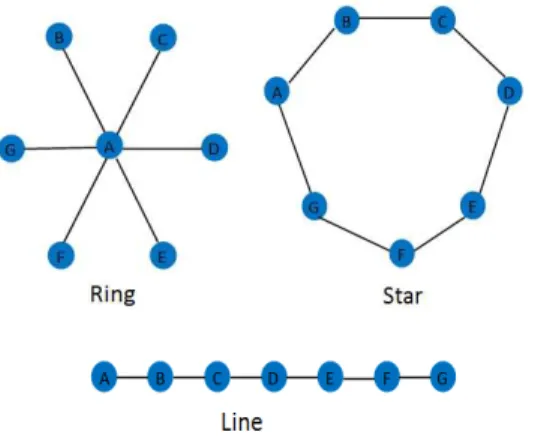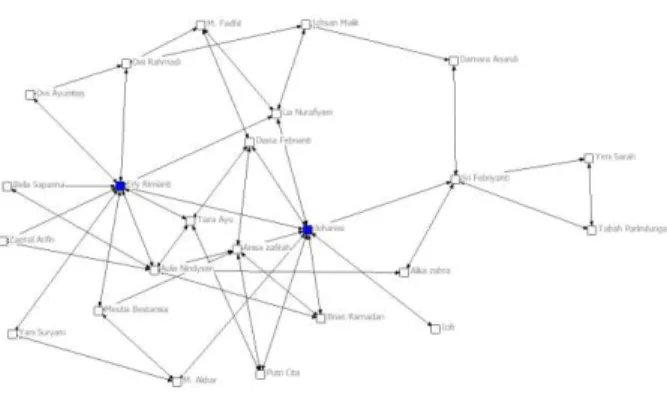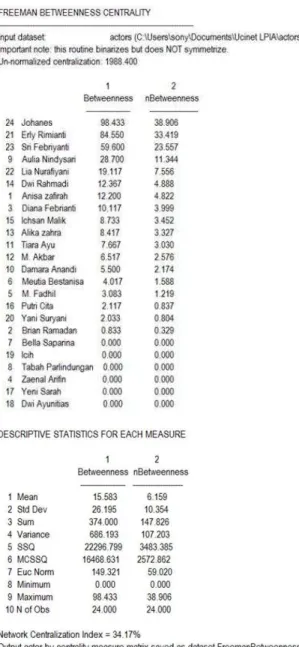Application of Social Network Analysis
for Mapping Patterns of the Learning Process
in LPIA Tambun
Febry de Fretes1, Wiranto H. Utomo2 and Danny Manongga3 1 Faculty of Information Technology, Satya Wacana Christian University
Salatiga, Central Java, Indonesia
2
Faculty of Information Technology, Satya Wacana Christian University Salatiga, Central Java, Indonesia
3
Faculty of Information Technology, Satya Wacana Christian University Salatiga, Central Java, Indonesia
Abstract
Social interaction is an important component in our lives. Social Network Analysis is a technique used today to describe and model the social interaction. The purpose of this study was to map the patterns in the learning process in the LPIA Tambun using Social Network Analysis. To identify the relationship of the actors and central actors in the network, this study analyse the density and eigenvector of ties as well as Freeman's centrality metrics of network. Analysis and visualization is done using Ucinet 6.0 and Netdraw. From the results of analysis, this study finds that the relationship of the actors in the network is categorized as a weak ties. Erly Rimianty become a central and influential actor in the network.
Keyword : Social Network Analysis, density and eigenvector of ties, Freeman’s centrality metrics.
1. Introduction
Learning is a system composed of several elements that interact to form a union. Elements of a learning system is student, faculty, facilities, materials, learning objectives, learning environment. Learning is a process of interaction between instructors and students. In the learning process students will gain about something they do not know, they will learn the knowledge in a more efficient, than the process will be a link on the new knowledge in a more stable cognitive structures, which can be obtained in the study [7]. The purpose of learning more emphasis to expand or add a student's knowledge, so that the student has the ability to express again the knowledge and understanding that have been studied, both within a short time or long time, which is obtained through a variety of ways in the learning process [4] .
Development of educational institutions is rapidly increasing nowadays, requires each institution to be able to fix the quality of education so as to maintain, enhance stakeholder satisfaction and confidence. LPIA (Indonesian
American Education Institute) that stood since 1995 and has 65 branches spread across several regions in Indonesia. LPIA is an educational institution that provides services to the stakeholders, namely students from elementary through high school, especially in the subjects of English Language and Computers. LPIA quality improvement efforts are also conducted every year by organizing training courses for all instructors. In addition to instructors skills, learning is also influenced by the success of teaching methods and student learning. Student relationship with the instructor can be used as a basis for assessing the success of a learning process.
SNA (Social Network Analysis) is a technique to study the social relations among members of a group of people. This study is intended to provide an overview of social networking that occurs between student and instructor in the learning process in LPIA Tambun, so it can help leaders to know the development of the learning process and make efforts in improving the performance and quality of the learning process in LPIA Tambun.
2. Research Questions
The research conducted is designed to answer the following questions :
1. How the map relations in social networks of the learning process at LPIA Tambun?
2. Which actors have an important role and influence in social networks of the learning process at LPIA Tambun?
3. Aim of The Research
important role in the social network in the learning process in LPIA Tambun
4. Theoritical Foundation
Network is a set of relations, networks have multiple objects (nodes) and the mapping or description of relations between the objects (nodes) [3]. To understand the approach used in network analysis, there are three types graph of networks: Star, Line, Circle [2]. To more clearly the three graph of network can be seen in Figure below
Fig 1. Three types graph of network
A graph or sociogram is composed of nodes or actors or points connected by edges or relations or ties. A graph may represent a single type of relations among the actors, or more than one kind of relation. Each tie or relation may be directed, or it may be a tie that represents co-occurrence, co-presence, or a bonded-tie between the pair of actors. Directed ties are represented with arrows, bonded-tie relations are represented with line segments [2].
Social Network is a field that has been researched and developed in the lst few years as it has direct influences to ways of thinking, conveying ideas either in web development or in other network structures [5]. One method to analyze a network is Social Network Analysis (SNA). SNA is a mathematics- based and could be implemented in many fields such as Computer Science, Geography, Information Science, Psychology, Biology, and many more [1][5]
Social netowrk Analysis is a technique for studying the social relationships between members of a group of people [8]. Social Network Analysis is used to understand the relationships (ties / edge) of the actors (nodes / points) that exist in a system with a second focus, the actors and the
relationships between actors in a particular social context. The focus is to help the understanding of how the position of the existing actors can affect access to existing resources such as goods, capital, and information [6].
Social Network analysis aims to visualize the relationships between different actors, which interact in a specific place. From the results of the visualization, there is some use of Social Network Anlysis :
1. Identify individuals, groups and units which play a major role.
2. Distinguish the information breakdown, bottleneck, structural holes, and also the individual, group and isolated units.
3. Advantage of the opportunity to accelerate the flow of existing knowledge, both functionally and organizationally.
4. Increase awareness of and reflection on the importance of informal networks and ways to improve organizational performance.
5. Strengthens the efficiency and effectiveness of existing formal communication channels.
6. Increasing support among the actors in the organization through relationships built in the network
7. Enhance innovation and learning for all members of the organization.
8. Find new strategies to be implemented in the achievement of organizational goals [6].
In performing measurements of the Social Network Analysis can be used terminology density and eigenvector, centrality and power. Density is a comparison between all the networks of existing relationships with all relationships that may exist. The density of a network can tell us about how information moves between the points in the network and also where the actor has a high social capital. Eigenvector approach is an effort to find out the most central actor in the network. Eigenvector investigates the global distance between actors in one dimension or ties pattern [2].
Social network analysis using the paradigm of 'centrality and power' can identify the central actors in a network that has the status / position in a more benefit, it can be said more powerful than the other actors in the network [2]. Analysis of centrality in a social network can provide knowledge about the role of an individual in its environment. The degree centrality (Degree centrality), closeness centrality (Closeness centrality) and the centrality of the Intermediary (Betweenness centrality).
a. In degree: an actor with a high degree in shows that the actor has an important role. This is because many actors are trying to get in touch with them.
b. Out degree: actors who have a high degree out shows that the actor was very influential position in a social network. This demonstrates the ability of an actor who is able to exchange information with other actors.
Closeness centrality is a measure of how much information can be spread from one actor to other actors. Moreover, Closeness centrality can also show the distance between one actor to another actor in a network. The higher the value the proximity of the actor, indicating the easier for the actor to disseminate information in the network. Instead, if the value of proximity is low, then the distance the actor with other actors far enough, so that the dissemination of information from informants is quite difficult actor to another actor.
Betweenness centrality is a measuring that includes how much a node / actor is able to control / control the flow of information between actors in the network. Betweeness high centrality of an actor showing the actor has a great capacity to facilitate interaction among the actors that are connected. In addition, Betweenness centrality: can also be used to measure how well does an actor, can facilitate communication with other actors in a network.
5. Research Method
In mapping the social networks for the learning process, there are stakeholders who are involved as research objects. This study uses the research object as the target population. Purposive sampling of data applied in this study. This research included in survey research. It uses questionnaires and interviews for data collection. Interviews were conducted by asking questions directly or indirectly to the respondent in the form of questionnaires. The number of respondents is 24 people consisting of 20 students and 4 instructors LPIA Tambun. Litelatur study was also conducted for the data collection process by reading litelatur-litelatur, books and references related to Social Network Analysis.
Social Network Analysis using the Full Network Method approach. Methods or procedures of this data collection is one of four possible methods in Social Network Analysis [2]. Data collected by gathering the information relationships between actors. This approach ties in the population census actors. Full Network of data makes it possible to obtain a description and a very strong social structure.
In data processing and analysis in the assessment process was conducted with Ucinet 6.0 and Netdraw . Both applications were developed by Borgatti, S.P. in 2002 at Harvard University as an Analytic Technologies. Ucinet 6.0 is used to create or compile a matrix of interaction between nodes / actors along with their attributes, which then visualized on Netdraw applications. In addition, to perform data analysis to look at the role of actors in a network, carried out by using theAnalysis tools that exist in the application Ucinet6.0.
6.
Analysis and Discussion
Trough the data processing using Ucinet 6.0 and Netdraw, the visualization of the social netwrok and its statistic description of the actors in the learning process at LPIA Tambun could be seen in the figure below.
Fig. 2 Sociogram social network of 24 actors
To see the depth of the visualization of social networks, as shown in figure 2, the following will discuss the relationship and interaction of the actors, as seen from some of the tools in Social Network Analysis, such as Density, Eigenvector and Freeman's Centrality Analysis.
6.1 Density
Fig. 3 Univariate Statistics of Density Matrix
6.2 Eigenvector
Based on figure 5, actor 21 (Erly Rimianty) is the actor with the highest eigenvector point wich is 0,426. So the central actor in the whole network is actor 21 (Erly Rimianty). Beside actor 21, another central actor that could be identified in the network are actor 22 (Johanes) and 9 (Aulia Nindysari) with eigenvector point 0,399 and 0,330.
Meanwhile the highest eigenvalue from the factor analysis is 4.860 and 16,8% of percentage pattern. This indicates that 16,8% of the ties has global pattern distance to the network of 4,860. The local pattern distance of the network is 2.683 with 9.3%. The next pattern will be a more local pattern.
Fig. 4 Sociogram Eigenvector of 3 Central Actor in Network
Fig. 5 Bonacich Eigenvector Centralities
6.3 Centrality Actor in the Network
6.3.1 Degree Centrality
Based on figure 8, actor 21 (Erly Rimianty) is the actor with the highest out-degree point wich is 10. This indicates that the actors are the central actors in the network. 10 point means that they send and recieve the information to 10 other actors. While actor with the highest in-degree point is actors 21 (Erly Rimianty), with 10 points. This is the central or focus actor as well as prominent actor. It indicates that many other actors try to send or receive ties from her. The 10 points means that this actor receive information form 10 other actors.
Fig. 7 Oout-degree Centrality Sociograms of central actors in the network
From result in figure 8, the average of out-degree and in-degree points of actors in this network is low, it is: 3,67, This indicates that each actors send and receive ties to and from 1 actors based on the total number of actors in the network.
Fig. 8 Measurement Result of Fremman’s Degree Centrality
6.3.2 Closeness Centrality
Based on figure 9, the Closeness Centrality measurement, actor 21 (Erly Rimianty) and 24 (Johanes) has the highest in-closeness point wich is 16,00. These two actor is more easily spread information compared to other actors in the network. Compared to the in-closeness Mean which is 11.514, shows that actor 21 (Erly Rimianty) and 24 (Johanes) receives information more than the average of the actors in the network.
Fig. 9 Measurement Result of Closeness Centrality
6.3.3 Betweeness Centrality
Fig. 10 Measurement Result of Freeman’s Betweeness Centrality
Based on figure 10, the level of network centralization index is low (34.17%). This shows that structurally there is no big power in the network. Actor 24 (Johanes), 21 ((Erly Rimianty), 23 (Sri Febriyanti) and 9 (Aulia Nindysari) seem to have structural power to be the communication facilitator in the network.
Actor who have the highest betweeness point is Actor 24 (Johanes) and 21 ((Erly Rimianty) wich is 98,43 and 84,55. This value indicates that these two actors have a big capacity to facilitate interaction between actors who are not connected to each other. Meanwhile actors with low betweeness point means that they do not have the capacity
to facilitate interaction between actors who are not connected to each other.
7. Conclusion
From the result of analysis and discussion it could be concluded that the ties made in the social network in the learning process at the LPIA Tambun are weak. Actors who have a role in the network is Erly Rimianty (Instructor), Johanes (Instructor) and Aulia Nindysari (Students). These actors have considerable potential as an influential actor in the network, because they have the capability to exchange information. In addition, Erly Rimianty (Instructor), an actor who has the ease of disseminating information to other actors, so that could be categorized as an actor who plays an important role as an information center. While the actors who have a structural strength to be a facilitator of communication in the network is Johanes, Erly Rimianty, Sri Febriyanti and Aulia Nindysari. Based on the mapping done using social network analysis, there are some suggestions that can be done for the social network of learning process. The suggestions considering the low influence of the actors in the network : first, it needs to increase the intensity and frequency of interactions (ties) of all the actors in the network. Second, considering the weak ties in the network, it needs to optimize the roles of the central actors in the network. Erly Rimianty (Instructor), the central actor, should be empowered existence.
References
[1] Carrington, P., Scott, J. & Wasserman, S., 2005. Models and Methods in Social Network Analysis. New York: Cambridge University Press
[2] Hanneman, Robert, A. and Mark Riddle. 2005. Introduction to social network methods. Riverside, CA: University of California, Riverside (published in digital form at http://faculty.ucr.edu/~hanneman/).
[3] Kadushin, Charles, 2004. Introduction to Social Network Theory. In Press. New York.
[4] Muchitch, Saekhan, M dkk, 2008 Pembelajaran Kontekstual, Semarang RaSAIL Media Group
[5] Otte, E. dan Rousseau, R., 2002. Social network analysis: a powerful strategy, also for the information sciences. Journal of Information Science, 28 (6) pp. 441–453.
[6] Serrat, Olivier, 2009. Social Network Analysis, Knowledge Solutions. Asian Development Bank (ADB).
[7] Uno, Hamzah, 2007, Pembelajaran Menciptakan proses belajar Mengajar yang Kreatif dan Efektif, Jakarta, Bumi Aksara
Febry de Fretes is a postgraduate student of Faculty of Information Technology, Satya Wacana Christian University , Salatiga, Central Java, Indonesia. he got a bachelor's degree at STMIK Jayakarta in 2005.
Wiranto Herry Utomo, a lecture at Faculty of Information and Technology at Satya Wacana Christian University Salatiga, Indonesia. He got a Master Degreein Computer Engineering at Gajah Mada University Yogyakarta Computer Science in 2002 and his Ph.D at Gajah Mada University in 2011. Research specialization of Dr. Ir. Wiranto Herry Utomo, M.Kom. is in the field of SOA, java EE, web services, and software engineering.




